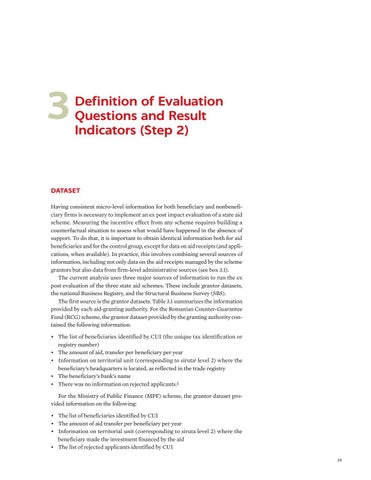3
Definition of Evaluation Questions and Result Indicators (Step 2)
DATASET Having consistent micro-level information for both beneficiary and nonbeneficiary firms is necessary to implement an ex post impact evaluation of a state aid scheme. Measuring the incentive effect from any scheme requires building a counterfactual situation to assess what would have happened in the absence of support. To do that, it is important to obtain identical information both for aid beneficiaries and for the control group, except for data on aid receipts (and applications, when available). In practice, this involves combining several sources of information, including not only data on the aid receipts managed by the scheme grantors but also data from firm-level administrative sources (see box 3.1). The current analysis uses three major sources of information to run the ex post evaluation of the three state aid schemes. These include grantor datasets, the national Business Registry, and the Structural Business Survey (SBS). The first source is the grantor datasets. Table 3.1 summarizes the information provided by each aid-granting authority. For the Romanian Counter-Guarantee Fund (RCG) scheme, the grantor dataset provided by the granting authority contained the following information: • The list of beneficiaries identified by CUI (the unique tax identification or registry number) • The amount of aid, transfer per beneficiary per year • Information on territorial unit (corresponding to siruta1 level 2) where the beneficiary’s headquarters is located, as reflected in the trade registry • The beneficiary’s bank’s name • There was no information on rejected applicants.2 For the Ministry of Public Finance (MPF) scheme, the grantor dataset provided information on the following: • The list of beneficiaries identified by CUI • The amount of aid transfer per beneficiary per year • Information on territorial unit (corresponding to siruta level 2) where the beneficiary made the investment financed by the aid • The list of rejected applicants identified by CUI 19

